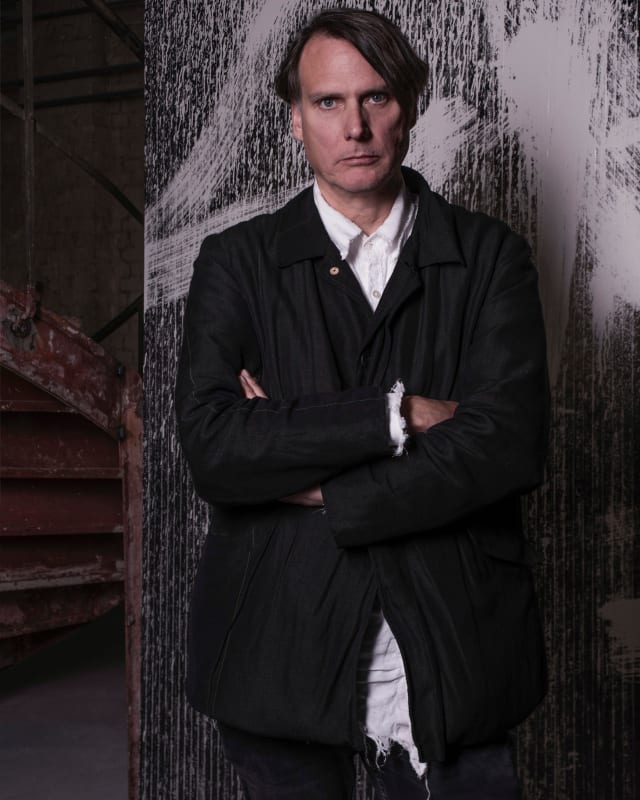Gregor Hildebrandt (b. 1974, Bad Homburg, Germany) is an artist whose work is defined by an engagement with the materiality of sound and its preservation in visual form. Working primarily with pre-recorded cassette tapes, vinyl records, and magnetic film, he transforms these obsolete audio carriers into paintings, sculptures, and installations that engage with Minimalism, Conceptualism, and personal memory. His practice is rooted in a process of layering, imprinting, and accumulation, creating works that are both physically restrained and conceptually expansive. Through these methods, Hildebrandt constructs a language of visual rhythm, where sound exists not as an audible presence but as an embedded, latent force.
Hildebrandt studied at Johannes Gutenberg University in Mainz before continuing his training at the University of the Arts in Berlin, where he graduated in 2002. During this period, he developed an early fascination with the material qualities of cassette tape, particularly its dual function as both a vessel for recorded sound and a physical medium capable of creating surface texture. His initial experiments involved recording songs onto tape, cutting the magnetic film, and pasting it into sketchbooks-an act that transformed ephemeral sound into a tangible, visual element. This early conceptual exercise would become the foundation for his signature technique: the rip-off painting.
In these works, Hildebrandt adheres magnetic tape to a canvas, presses it down with a roller or brush, and then removes it, leaving behind a delicate imprint of the tape's surface. This process is repeated multiple times before the residual tape is permanently affixed to the canvas, creating a dual structure where one painting retains the ghostly trace of the original, and the other preserves the actual material. These works are often monochromatic, with black cassette tape dominating his compositions, resulting in surfaces that appear minimal but carry the weight of embedded sound. His early rip-off paintings drew attention for their ability to evoke a sense of absence and memory, positioning his work within a dialogue between materiality and erasure.
While painting remains central to Hildebrandt's practice, his exploration of sound extends beyond the canvas into sculptural and architectural interventions. His sculptures frequently incorporate repurposed vinyl records, shaped into concave forms that resemble bowls or stacked into towering columns. These structures reference both classical sculpture-particularly the totemic arrangements of Constantin Brancusi-and the physicality of recorded media. Hildebrandt describes these works as "sonic walls," suggesting that even in their sculptural transformation, the records retain an aura of their original function. His architectural installations take this approach further, with projects like Hirnholzparkett (2015), in which thousands of cassette tapes were embedded into epoxy resin and laid out as flooring, turning a storage medium for sound into a silent yet immersive environment.
Hildebrandt's engagement with music is deeply personal, yet his references extend beyond autobiography into broader cultural and historical narratives. His works often bear titles derived from song lyrics, literary passages, or film references, embedding them within a network of associations that encourage multiple readings. In Cheers for Tears (Tocotronic) (2007), he pays homage to the German indie rock band Tocotronic, while Big in Japan (Alphaville) (2021) references the 1980s pop hit, merging musical nostalgia with the formal language of abstraction. This interplay between personal affinity and shared cultural memory situates Hildebrandt's practice within a lineage of artists who have explored the materiality of sound, including Christian Marclay, who manipulates recorded media as a performative act, and Douglas Gordon, whose film-based works explore the relationship between time, repetition, and memory.
Despite its conceptual depth, Hildebrandt's work retains a strong material presence. His process is rooted in meticulous craft, with each artwork requiring a labor-intensive method of application and removal. His monochrome compositions, often appearing as smooth, reflective surfaces from a distance, reveal intricate details upon closer inspection, where the minute imperfections of the tape's surface create a dynamic, textured interplay of light and shadow. This sensitivity to material echoes the concerns of Arte Povera, where everyday materials are elevated into the realm of high art, yet his strict adherence to formal structure aligns him more closely with Minimalist tendencies.
Throughout his career, Hildebrandt has maintained a steady presence in both institutional and commercial contexts. His first major institutional recognition came in 2009 with Der Himmel im Raum at the Berlinische Galerie, which established his ability to translate his aesthetic concerns into an immersive exhibition format. This was followed by a series of critically regarded solo exhibitions, including Behind My Back, In Front of My Eyes (Perrotin Hong Kong, 2021) and Ein Wimpernschlag und hinter uns die Jahre (Kunsthalle Praha, 2022). His work has also been featured in prominent group exhibitions, such as A History: Art, Architecture, Design from the 80s to Now at Centre Pompidou (2014) and Re-inventing Piet: Mondrian and the Consequences at Kunstmuseum Wolfsburg (2023).
Hildebrandt's work is held in major public and private collections, including the Centre Pompidou (Paris), Berlinische Galerie, Rubell Family Collection (Miami), and Yuz Museum (Shanghai). His institutional acquisitions reflect the wide appeal of his practice, which resonates with collectors and curators who recognize his ability to merge conceptual rigor with formal elegance.
In addition to his artistic practice, Hildebrandt is an active curator and supporter of emerging artists. Since 2017, he has operated Grzegorzki Shows, an independent exhibition space in Berlin dedicated to showcasing experimental and underrepresented voices in contemporary art. His curatorial initiatives extend his interest in material dialogue, providing a platform for artists who engage with the intersections of sound, text, and abstraction.
Despite the technological obsolescence of cassette tapes and vinyl records, Hildebrandt continues to find new ways to push the boundaries of his medium. Recent works have seen a subtle introduction of color, derived not from paint but from the natural pigments found within his materials. These shifts demonstrate an evolving practice, one that remains anchored in its core concerns while continually adapting to new aesthetic and conceptual possibilities.
Hildebrandt's work ultimately engages with the fragility of memory and the persistence of recorded media in an age where digital formats dominate. His art does not seek to preserve the past nostalgically but rather to interrogate how sound-once fixed in physical form-can be reinterpreted through visual means. By transforming obsolete media into objects of contemplation, he invites viewers to consider the ways in which cultural memory is stored, erased, and reimagined. Through this process, he constructs a body of work that is both deeply personal and universally resonant, offering a meditation on time, materiality, and the unseen traces that shape our experience of the world.

